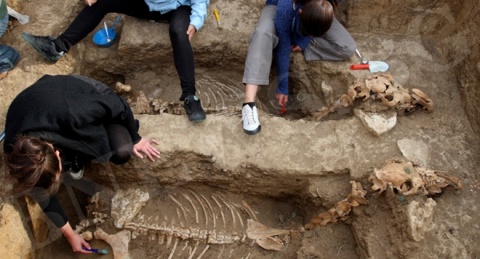by Sarah Griffiths
The Daily Mail
Archaeologists have uncovered the remains of a Thracian carriage and two horses that appear to have been buried upright.
The chariot and horse skeletons are 2,500-years-old and were discovered in the village of Svestari in north-east Bulgaria.
The two-wheeled carriage and carcasses of the horses were found in a Thracian tomb along with some decorations.
Professor Diana Gergova of the National Archaeology Institute at the Bulgarian Academy of Sciences, who led the dig, said: 'The find is unique, it is not resembling any other carriage dating from the Thracian era ever uncovered in Bulgaria.'
According to Sofia News Agency, the discovery of the carriage was unexpected as treasure hunters have plundered many of the ancient mounds found in the region in a bid to find gold, despite a UNESCO ban of this activity.
The particular mound where the carriage was discovered, is adjacent to the well known Mound of Bulgarian Khan Imurtag, where the same research team uncovered a hoard of gold last year.
A Roman chariot complete with a seat and boot was unearthed along with two buried horses in the village of Borissvovo in Bulgaria in 2010, which shows similarities to the new find, despite being younger in age.
It was thought to belong to Thracian nobility living in the second half of the 1st century AD, judging by the imported goods found in nearby graves.
The burial mount yielded seven burial structures and two pits, one of which held the carriage and horses, HorseTalk revealed.
Experts believe the chariot was placed in a narrow hole with a sloping side to allow horses, decorated with elaborate harnesses, to pull it into its final resting place, after which they were killed.
The evidence of small metal disks on the horses' heads at the new sight, suggest they too were wearing harnesses.
The Borissovo chariot was supported by stones in order to keep it in its final position and offers researchers the chance to see how the vehicles were put together, including a 'boot' which held a bronze pan and ladle, grill and bottles.
A skeleton of a dog chained to the cart was also discovered, and nearby the grave of the warrior who is presumed to have owned the carriage, complete with his armour, spears and swords as well as medication and an inkwell, signifying he was well educated.
Archaeologist Veselin Ignatov, who was involved in the discoveryry of another the chariot near the southeastern village of Karanovo, said around 10,000 Thracian mounds - part of them covering monumental stone tombs - are scattered across the country.
Mr Ignatov said up to 90 per cent of the tombs in the region have been completely or partially destroyed by treasure hunters who smuggle the most precious objects abroad.
*The title has been changed by Novinite.com (Sofia News Agency)


























